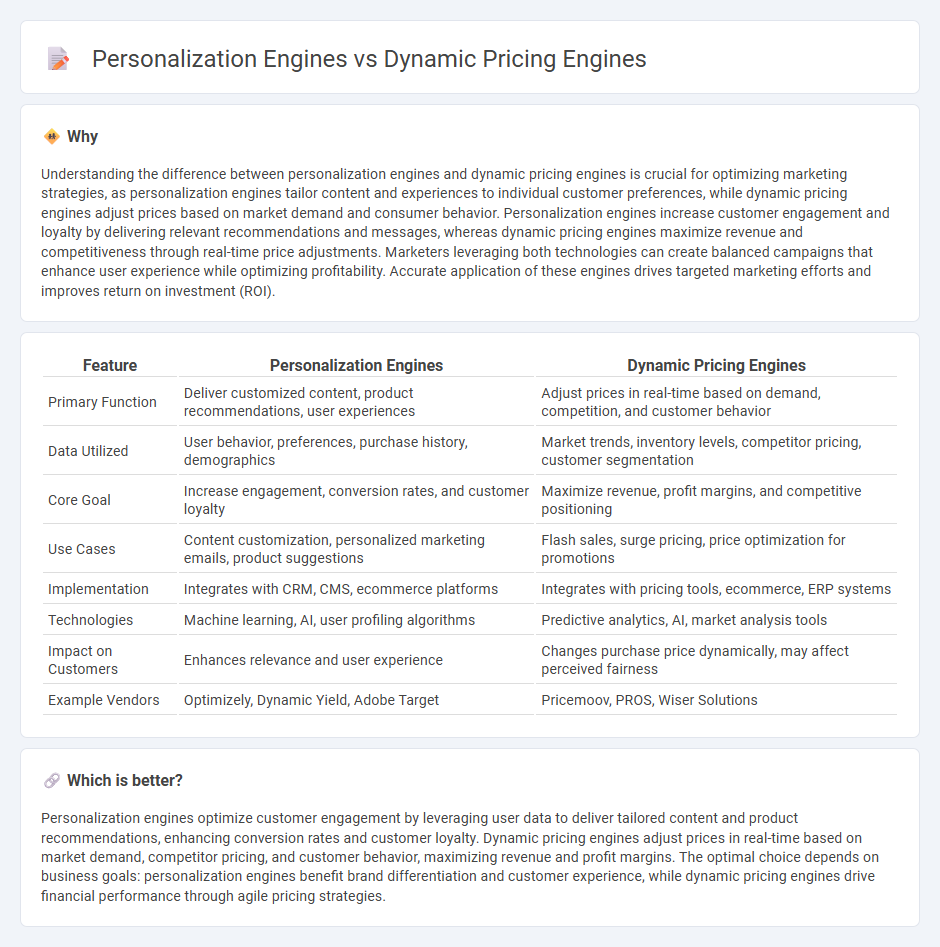
Personalization engines analyze customer data and behavior to deliver tailored content and product recommendations, enhancing user experience and boosting engagement. Dynamic pricing engines adjust prices in real-time based on market demand, competitor actions, and customer segments to maximize revenue and competitiveness. Explore how these powerful technologies can transform your marketing strategy.
Why it is important
Understanding the difference between personalization engines and dynamic pricing engines is crucial for optimizing marketing strategies, as personalization engines tailor content and experiences to individual customer preferences, while dynamic pricing engines adjust prices based on market demand and consumer behavior. Personalization engines increase customer engagement and loyalty by delivering relevant recommendations and messages, whereas dynamic pricing engines maximize revenue and competitiveness through real-time price adjustments. Marketers leveraging both technologies can create balanced campaigns that enhance user experience while optimizing profitability. Accurate application of these engines drives targeted marketing efforts and improves return on investment (ROI).
Comparison Table
| Feature | Personalization Engines | Dynamic Pricing Engines |
|---|---|---|
| Primary Function | Deliver customized content, product recommendations, user experiences | Adjust prices in real-time based on demand, competition, and customer behavior |
| Data Utilized | User behavior, preferences, purchase history, demographics | Market trends, inventory levels, competitor pricing, customer segmentation |
| Core Goal | Increase engagement, conversion rates, and customer loyalty | Maximize revenue, profit margins, and competitive positioning |
| Use Cases | Content customization, personalized marketing emails, product suggestions | Flash sales, surge pricing, price optimization for promotions |
| Implementation | Integrates with CRM, CMS, ecommerce platforms | Integrates with pricing tools, ecommerce, ERP systems |
| Technologies | Machine learning, AI, user profiling algorithms | Predictive analytics, AI, market analysis tools |
| Impact on Customers | Enhances relevance and user experience | Changes purchase price dynamically, may affect perceived fairness |
| Example Vendors | Optimizely, Dynamic Yield, Adobe Target | Pricemoov, PROS, Wiser Solutions |
Which is better?
Personalization engines optimize customer engagement by leveraging user data to deliver tailored content and product recommendations, enhancing conversion rates and customer loyalty. Dynamic pricing engines adjust prices in real-time based on market demand, competitor pricing, and customer behavior, maximizing revenue and profit margins. The optimal choice depends on business goals: personalization engines benefit brand differentiation and customer experience, while dynamic pricing engines drive financial performance through agile pricing strategies.
Connection
Personalization engines leverage user data to customize marketing content and product recommendations, while dynamic pricing engines analyze real-time market conditions and customer behavior to adjust prices accordingly. Both systems rely on data analytics and machine learning algorithms to enhance customer engagement and maximize revenue. Integrating these engines enables marketers to deliver tailored offers at optimized price points, improving conversion rates and customer satisfaction.
Key Terms
Real-time Data Analysis
Dynamic pricing engines leverage real-time data analysis to adjust prices instantly based on market demand, competitor pricing, and inventory levels, maximizing revenue and competitiveness. Personalization engines utilize real-time customer behavior data to tailor product recommendations, offers, and content, enhancing user experience and conversion rates. Explore how integrating these technologies can optimize your business strategy and drive growth.
Price Optimization
Dynamic pricing engines leverage real-time data analytics and machine learning algorithms to adjust prices based on market demand, competitor pricing, and inventory levels, enhancing price optimization efficiency. Personalization engines analyze customer behavior, preferences, and purchase history to tailor pricing strategies for individual segments, improving conversion rates and customer satisfaction. Explore how integrating dynamic pricing with personalization engines can maximize your price optimization outcomes.
Behavioral Segmentation
Dynamic pricing engines adjust prices in real-time based on consumer behavior, market demand, and competitor pricing, while personalization engines tailor product recommendations and content to individual user preferences using behavioral segmentation data. Behavioral segmentation categorizes customers by actions such as browsing history, purchase frequency, and engagement patterns, enabling both engines to optimize user experience and revenue generation effectively. Explore how integrating behavioral segmentation into dynamic pricing and personalization engines can enhance business growth and customer satisfaction.
Source and External Links
Dynamic Pricing Rule Engine - This blog explores the concept of dynamic pricing and its implementation through rule engines, highlighting its significance in industries like e-commerce and travel.
The Ultimate Guide to Dynamic Pricing Software - Dynamic pricing software adjusts prices based on real-time market conditions, customer demand, and competitor strategies, maximizing revenue and profit margins.
What is a Dynamic Pricing Engine? - A dynamic pricing engine ensures prices are relevant to current market and channel conditions, optimizing them in real-time.
 dowidth.com
dowidth.com